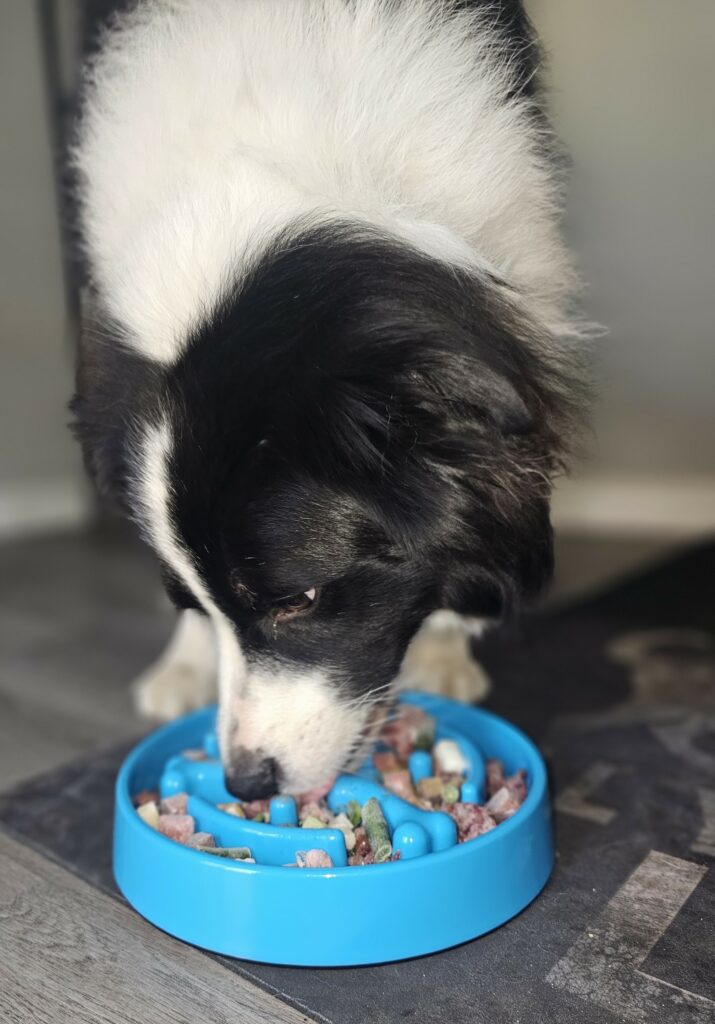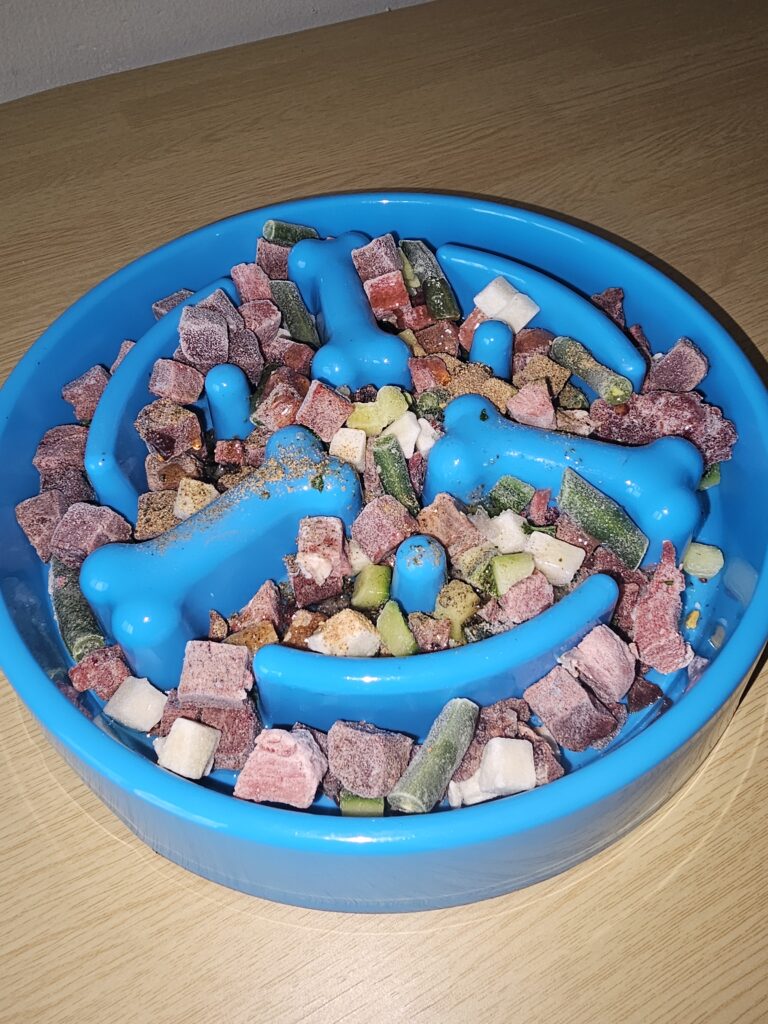How to Feed Your Dog for Better Health—Without Breaking the Bank
If you’re reading this, you’re likely aware that ultra-processed kibble isn’t the healthiest option for your dog. But making the leap to a healthier diet can be overwhelming. There are countless dog food options, many of which are expensive, and switching can seem complicated. Plus, let’s be honest: kibble is convenient! It doesn’t require fridge space or preparation, making it easy for busy dog owners.
If preparing homemade meals for your dog feels too time-consuming or complex, don’t worry! Improving your dog’s diet doesn’t have to be an all-or-nothing overhaul. Small steps can make a difference without breaking the bank.
Start Small: 10-20% Healthier Food Additions
You don’t need to change your dog’s entire diet overnight. Instead, start by replacing 10-20% of your dog’s regular kibble with healthier, whole foods. Think of it like adding a few nutritious sides to your dog’s meal. You can also switch out commercial treats for healthier alternatives to gradually boost your dog’s diet without a big commitment.
Healthier Treat Options for Your Dog 🦴
A few small changes in treats can significantly impact your dog’s health. Here’s a list of easy, affordable options you can cut into small pieces to stretch your budget while providing great health benefits:
- Frozen Blueberries – These antioxidant-rich snacks are high in fiber and refreshing.
- Carrot Slices 🥕 – Low in calories and full of vitamins, carrots make a perfect low-fat snack.
- Cooked Meat Pieces 🍗 – Lightly cooked chicken or other meats offer protein-rich treats. Just slice them small!
- Brussels Sprouts 🥬 – Known for their anti-cancer properties, Brussels sprouts are nutrient-dense and can be served fresh or lightly steamed.
- Cucumber 🥒 – Nearly calorie-free and mostly water, cucumbers make a hydrating snack.
- Broccoli Sprouts 🥦 – These sprouts offer anti-aging benefits and are rich in essential nutrients.
- Organ Meats (like liver, kidney, and heart)—Lightly cooked and sliced, organ meats are a nutritious treat that dogs love.
- Frozen Sardines 🐟 – Full of protein and Omega-3s, freeze sardines for a crunchy snack.
- Fresh Fruits (except grapes and raisins) 🍎 – Most fresh fruits are great in moderation, but choose low-sugar varieties.
By switching to these healthier treats, which make up around 10% of your dog’s daily intake, you’re reducing reliance on processed options and adding longevity-boosting nutrients. Plus, many of these treats can be cheaper than store-bought options, saving you money in the long run!💰
Building Healthy Habits 🐕
Sometimes, dogs accustomed to commercial treats might initially be picky about new, healthier options. When I introduced Zen to carrots for the first time, he sniffed and walked away. But with a little encouragement, like a dab of cheese or sour cream, he soon warmed up to them. Over time, he even began enjoying them on his own.
Take It a Step Further: Replace One Kibble Meal with a Healthier Option
Consider replacing one of your dog’s kibble meals with a healthier option for an even bigger impact. If making food at home feels like too much of a commitment, start with quality pre-prepared food from the market. There are several options:
Raw food diets use high-quality, unprocessed ingredients to provide optimal nutrition, resembling a dog’s natural diet. Despite common misconceptions, raw food is safe when properly stored and handled. Many worry about bacteria, but dogs’ digestive systems are well-equipped to handle raw foods, making them more efficient at processing and absorbing nutrients from unprocessed food.
1. Raw Food
Raw feeding is the best thing you can do for your dog. It does require freezer or fridge storage, but there are convenient solutions that fit easily into a busy lifestyle. You can buy pre-made raw food or make your own. There are many pre-made raw foods on the market, and many are balanced according to the AAFCO rules. You can also make your food, which is less expensive but requires some knowledge about balancing nutrition. Check out my free course on raw feeding HERE.


2. Fresh Cooked Food
Fresh-cooked meals can be an excellent choice if you’re unsure about raw food or prefer cooked options. And it is second best choice for your dog, Many companies offer lightly cooked, nutritionally balanced meals that provide similar benefits to raw food with the added comfort of cooking. When choosing a fresh food provider, look for brands with high-quality ingredients and transparent nutrition labels. Be aware that pre-made cooked food can also have unwanted fillers. You can also cook your dog meals at home, but it requires basic knowledge of nutrition. I will launch my course about home-cooked food for dogs soon. This option offers a middle ground, preserving nutrients while still being gentler on the stomach for some dogs.
3. Air-dried or Freeze-Dried Food
Air-dried and freeze-dried foods are also great options, especially for those short on freezer space. These foods undergo a low-temperature drying process that preserves nutrients without refrigeration, making them highly convenient for storage and travel. Although these options can be a bit more expensive, they offer the benefits of raw or lightly cooked diets while maintaining a shelf-stable convenience similar to kibble.
Whatever option you choose, do some research beforehand. Always read labels and, if possible, order a small sample to see if your dog enjoys it before committing to a whole bag. When reading labels, aim for a balanced mix to support your dog’s overall health:
- 40-60% protein
- 30-50% fat
- less than 10% fiber and carbs
This ratio helps ensure your dog receives a nutrient-dense, balanced diet. If you haven’t already, listen to my free courses about nutrition, how to read labels and find better kibble, and other alternative feeding solutions; join my community HERE.
Overall Recommendations: Beyond What to Eat, Consider How to Eat 🐾
Improving your dog’s health goes beyond just what you feed them—it’s also about how you feed them. Minor adjustments in feeding routines and the type of food you serve can lead to meaningful changes. Here are some ways to improve your dog’s health through both food choices and eating habits:
1. Add Fresh Food to Their Bowl 🍗
As I explained above, fresh food is valuable for dogs! For the truth about kibble and its impact on your dog’s health, read HERE. If you’re not ready for a complete raw or fresh diet, consider adding some fresh foods to your dog’s regular meals or treats. Whole foods like lean meats, fruits, and veggies can improve your dog’s nutrition, even in small amounts.
2. Watch Their Portion Sizes ⚖️
Overfeeding is a leading cause of health issues in dogs, often resulting in weight gain and reduced lifespan. Adjust portions based on your dog’s weight, energy level, and body condition rather than solely following commercial food guidelines. Prioritize protein-based meals to avoid weight gain associated with high-carb foods.
3. Limit Meal Times, Skip the Snacks 🍽️
A consistent eating window can benefit dogs (and us) by giving their bodies time to rest and process food fully. Instead of snacking all day or leaving food out, feed your dog at set times each day. Fewer opportunities to snack help regulate their digestion and support a healthy metabolism, just as intermittent eating benefits us.
Incorporate these simple adjustments—adding fresh food, managing portions, and establishing meal times—to support your dog’s health. You’ll likely notice positive changes in their energy and well-being, proving that small steps can make a big difference. Remember, while we control our diets, our dogs depend on us to make the best choices.
Small Steps, Big Changes! 🐾
If your dog is overweight, switching from kibble to raw food can be one of the easiest and most effective ways to start seeing improvements. Raw food, with its high protein content and natural ingredients, helps dogs shed excess weight more effectively than highly processed kibble.
For more tips on managing your dog’s weight, please check here for additional advice and guidance on keeping your pup healthy.

2 Responses
I have cooked my pupys food since she came last Dec/She was 3 lbs 5 months old and a maltese.She is now 5 lbs.There is so much info on cooking food for dogs and too much controversary.She dies not like things mixed together so I keep things separate.I alternate ground turkey chicken and beef.She gets brown rice with veggies.I boil chicken hearts gizzards and liver she gets small bits of this,She gets a egg once a week She gets cottage cheese.She does not like yogurt or sardines.The vet has given a multi vitamin and a pro biotic.I am always concerned that she is not getting everything she needs.Breakfast is 3 tabl of food.At night she may get something I am eating if healthy.Night she gets treats and cheerios.Small amount.I cut up carrots she like green beans.
All the ingredients sound great and definitely a step up from kibble! What is the percentage of rice and meat in your recipe? Since you’re not including any bone, I’d recommend adding a calcium and phosphorus source—these are crucial for dogs, especially puppies. Don’t forget Omega-3 for overall health. If you’d like to discuss your dog’s diet further, feel free to join my FREE community here: https://www.skool.com/dog-food-truth-qa-2530/about. 😊